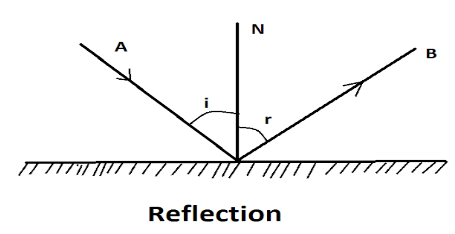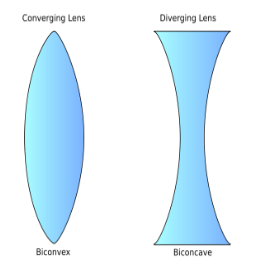Introduction
Reflection is a phenomenon wherein, when a wave hits a surface, it does not get absorbed. Instead, the incident energy is sent back from the surface. Metal surfaces can reflect as much as 80-90% of the light when highly polished and most commonly, mirrors are made using a silver coating that is deposited on the backside of the glass. The Hale Telescope located atop Mount Palomar in California is the world’s most reflective surface.
Similarly, refraction occurs when a wave crosses from one medium to another, which changes its direction and speed. One of the most commonly used optical devices is a lens, which is formed by the intersection of two spherical surfaces.

What is a lens?
A lens is one of the most commonly used optical devices made up of two intersecting spherical surfaces. The lens is said to be thin when the distances between the surfaces become small and it is not necessary for both of the surfaces to be spherical. In fact, one of them can be a plane as well. The line joining the centre of the two surfaces is known as the principal axis and the plane through this axis is known as the principal section of the lens. A point that lies on the principal section is known as the optical centre.
There are two types of lenses: Converging lenses, and diverging lenses.

Types of lens
Difference between Lens and Mirror

What is the concave lens?
A concave lens is a type of lens that diverges a straight light beam, creating a virtual image that is smaller than the object itself. Both sides of the concave lens are curved inwards, giving it a concave shape. Due to this shape, these lenses are also known as diverging lenses as they cause light rays to spread out. For instance, when a ray coming from the sun falls on a concave lens parallel to the principal axis, it appears to emanate from a point on the principal axis known as the primary focal point of the lens.
Similarly, when a parallel ray is emitted from the opposite side of the lens, it will also appear to converge to the primary focal point, typically denoted by the letter ‘F’. Further, a light beam originating from the focal point will become parallel to the principal axis after passing through the lens.
Lens formula for concave lens
The lens formula is an equation applicable to all types of lenses and relates the distance of the object (u), the image distance (v), and the focal length of the lens. In the form given below, it is valid only for a thin lens but formulae for thick lenses have also been derived:

What is the convex lens?
A convex lens protrudes outwards on both sides and is thicker in the centre and thinner at the edges. It is called convex because it concentrates the light falling on it. When a light beam parallel to the primary axis falls on the lens, it passes through the primary focal point on the other side. Similarly, when a light beam originates from the primary focal point and hits the lens, it emerges parallel to the principal axis.
One common example of the effects of this lens may be seen when it is held towards the sun and sunlight is focused on a piece of paper. The sharp, radiant image of the sun obtained this way is bright and has concentrated all the light rays in one point. This concentration is strong enough to burn the paper and the images formed this way are called real images.
Lens formula for convex lens
The lens formula for convex lenses is the same as that for concave lenses. That is,

Uses of convex and concave lens
Convex Lens
- Convex lenses are used to manufacture magnifying glasses.
- Microscopes utilise convex lenses.
- People suffering from hypermetropia are prescribed convex lenses, which can help focus the image correctly on the retina.
- Convex lenses are also used in cameras.
Concave lens
- Just like hypermetropia, myopia is corrected by using concave lenses.
- Flashlights, binoculars, telescopes, eyeglasses, etc. are common devices that use concave lenses.
Summary
A lens is a translucent medium formed by the intersection of two spherical surfaces or a spherical and a plane surface. When the surfaces are close, a thin lens is formed. There are two types of lenses: convex and concave. A convex lens protrudes outwards on both sides and is wide in the centre and narrow at the edges. A concave lens is bent inward on both sides and diverges the light rays that pass through it, earning it the name of diffuse lens. Ordinary mirrors are silver-coated on the back of glass. The Hale Telescope on Mount Palomar, California is the world’s largest reflector.
Frequently Asked Questions
1. What is the law of light reflection?
There are two statements related to the law of reflection:
- The incident ray, the reflected ray, and the surface normal will lie in one single plane.
- The angle made by the incident and reflected rays with the vertical will be equal.
2. Define the power of a lens.
The power of a lens physically means its ability to bend light. Mathematically, it is measured as the inverse of the focal length of the lens.
3. Calculate the power of a lens made of glass with a focal length of 150cm.
Given; Focal length

Since the focal length and thus, the power is positive, this lens is concave.
4. What is Prism?
A prism is a solid object made of high quality glass, consisting of three non-parallel rectangular planes. One of these planes is the base, while the other two are polished and known as the refracting surfaces. The rough surface is called the base and the prism is made by joining all three surfaces to form a 3D triangle of sorts.
5. The focal length of the concave lens is 15cm. If an image is to be formed at 10 cm, how far should the object be placed from the lens?
We are given that
v=-10 cm f=-15 cm
Our job is to find u, which can be done via the lens formula

Thus, the image must be placed 30 cm to the left of the lens.
6. State Two Differences Between a Convex and a Concave Lens ?
- Shape:
- Convex Lens: A convex lens is thicker in the middle and thinner at the edges. It has a shape that bulges outward, like the exterior of a sphere. It is also referred to as a converging lens because it focuses parallel light rays towards a single point.
- Concave Lens: A concave lens is thinner in the middle and thicker at the edges. Its shape curves inward, resembling the interior of a sphere. This type of lens is also called a diverging lens because it spreads parallel light rays away from each other.
- Focal Point and Image Formation:
- Convex Lens: When parallel light rays pass through a convex lens, they converge or come together at a single point known as the focal point. Convex lenses can form both real and virtual images, depending on the object’s distance from the lens. Real images are formed when the object is placed beyond the focal length and are inverted, while virtual images are formed when the object is placed within the focal length and are upright.
- Concave Lens: When parallel light rays pass through a concave lens, they diverge or spread out. As a result, concave lenses only form virtual, upright, and reduced images. The focal point of a concave lens is the point from which the diverging rays appear to originate when extended backward.
 Mission Statement
Mission Statement
“Empower every student to achieve full potential”
88Guru has been established with the social objective of making quality video-based learning material available to all Indian students. Technology, Connectivity and Social Media are rapidly changing the world of Education and we wish to lead the transformation of the tuition industry in India.
88Guru is the perfect complement to the current tuition model. 88Guru creates a wonderful opportunity for children and parents to bond while engaging in a valuable learning activity. It also provides the complete curriculum at your fingertips for those moments when you need some help at short notice. We believe that this mode of tuition could be transformational, adding hours to a child's day while providing complete control over the learning process.
Every course is taught by the best teachers from India's top schools and conducted in an engaging manner to keep students involved. The e-learning process consists of video-based instructions, computer-graded assignments, and a dashboard which allows the student and parent to track progress.



